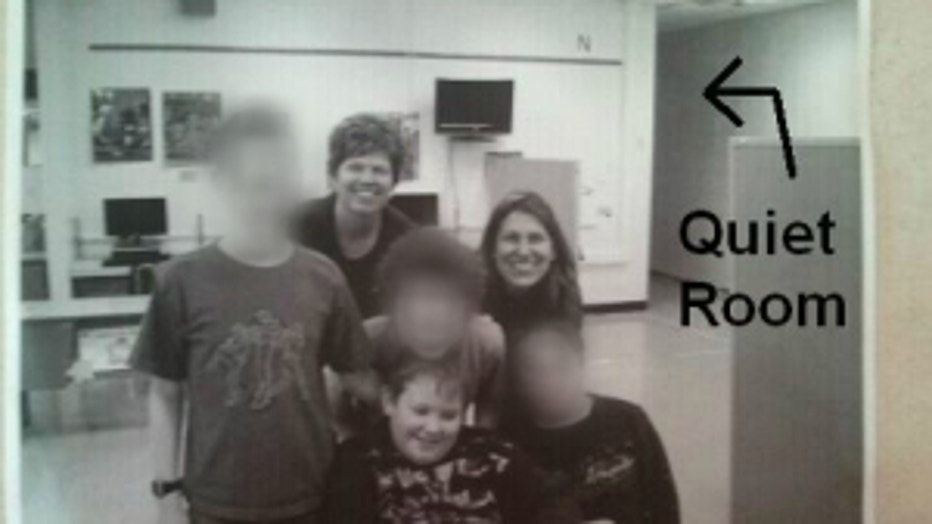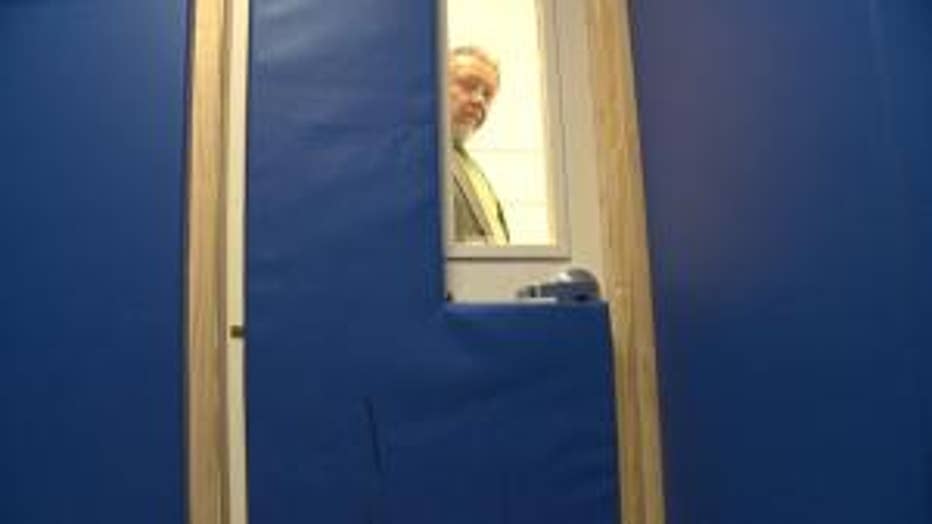Mom says school put her autistic son "in a box"
WAUPUN -- It's a room built for solitary confinement, but it’s not a cell at Waupun State Prison. It’s a ‘time out’ area at Rock River School, just a few blocks away.
"It`s a very common thing to have in public schools," Donald Childs, Superintendent of the Waupun Area School District said.
Teachers call it the ‘Quiet Room.’ The mother of an autistic child calls it ‘the box.’
"It's a boxed roof. It's an enclosed box," Mandy Rennhack said. "It's not a box. It is a room," Childs counters.
It's a room that Childs says is vital for calming children down who are out of control, but the superintendent was hardly eager to have FOX6 News show it to viewers. When FOX6 Investigators asked to see the room, the superintendent flatly answered, "No."
Why not?
"Because I am not going to allow the media into the classroom and into the building. This is a school, not a circus," Childs said.
Childs eventually changed his mind and allowed FOX6 Investigators to see the room after school hours. That's when FOX6 discovered that Superintendent Childs had never actually seen the room himself.
Rennhack first saw it last September when her nine-year-old son, Tyler, ended up inside.
"It`s built as though you built it to cage a child in there," Rennhack said.
Tyler has Asperger's Syndrome, an autism spectrum disorder characterized by social difficulty and occasional, but intense, emotional outbursts.
"I want to really educate a lot of people about Asperger's and autistic kids because they're not naughty," Rennhack said.
Last fall, Rennhack got a call from Tyler’s father. Tyler had a meltdown at school. "He told me there were two cops and he was locked in a plywood box," Rennhack recalls.
The next day, Tyler's mom demanded to see where the school had been holding her son. She says a teacher first led her to a regular classroom. Rennhack insisted on seeing "the plywood box."

"She walked me to the back of the classroom and it is hidden behind a concrete wall," Rennhack said.
When Dr. Childs led FOX6 Investigators to the "Quiet Room," we saw exactly what Rennhack had described -- a temporary room built of plywood. It measures seven feet deep by five feet wide, and stands just under eight feet tall. It is a chairless room with padded walls, a tile floor, no ventilation and a handle that locks when you hold it.
When Rennhack first saw the room, she says, "I cried." Rennhack asked if she could take pictures, but says the school told her no. "They're ashamed of it," Rennhack said.
Rennhack then secretly recorded video with her cell phone and showed it to Tyler’s doctor.
"I was horrified. Horrified," Dr. Elizabeth Britton, a family physician and the mother of an autistic child herself, said. Last fall, Dr. Britton asked the school not to put Tyler in the quiet room anymore.
"It didn't seem appropriate for any child, and they said, 'No, it will only be used as a last resort,'" Britton said.
"I told them that I did not want him in there," Rennhack adds.

"I am fully cognizant of the fact that the mother is not happy with that. She has never been happy with it," Childs said.
Seclusion and restraint of students in schools has been controversial for years.
In 2009, the Department of Public Instruction issued directives to schools that it should only be considered as a ‘last resort’ in ‘cases of danger.’
"What we are really finding is that seclusion or restraint is not an effective tool for managing challenging behaviors," Sara Daniel, a child psychologist with St. Aemilian-Lakeside in Milwaukee, which trains local educators in alternatives to shutting troubled kids away in isolation, said.
"We are actually re-enacting the physical feelings they have inside their body that occur during a trauma," Daniel said.
Earlier this year, Daniel testified in favor of a new law that bans the use of “seclusion and physical restraint” in schools, except when there is an “imminent risk to the physical safety” of a student or others. Even then, for “no longer than necessary to resolve the risk.”
The new law doesn’t take effect until September, but Superintendent Childs said they already comply with it. "We do not place children in there unless there is that presence of danger," Childs said.
Or do they? After months of good behavior at school, Tyler came home on March 27th with troubling news.

"'Mom, mom, you know what they did to me today?'" Rennhack remembers Tyler saying. "And I said, 'What?' And he had said that he was put in the box all day."
"Because I was walking around and annoying everybody," Tyler remembers.
According to Tyler’s teacher, he was pacing around the room and refusing to follow directions. "He began to exhibit behaviors that are identified as his 'trigger' behaviors for a major meltdown," Childs said.
Tyler's teacher directed him into the ‘Quiet Room.’ The door was shut and another teacher held the lock.
"There was nothing provocative whatsoever. He was just saying, 'No, no, no,' and pacing," Britton said. "He was being a little disruptive and a little noisy, so the door was closed for a very few minutes," Childs said.
"Seclusion and physical restraint" is only supposed to be used when there is “imminent risk” to others. In a meeting with school staff that Rennhack recorded, Tyler’s teacher admits he never had a meltdown.
EXCERPT FROM RECORDING:
Teacher: "Not complying with adults puts up little flags for me that something's not right if he's not following my directions."
Rennhack: "Was he at a risk to himself or others?"
Teacher: "You know what, he was pacing around the room."
Rennhack: "Was he at a risk to himself or others?"
Teacher: "I felt he was a potential at risk to himself or others. He was causing them not to learn."
Rennhack: "That's not a risk."
Rennhack says when she first asked about the incident, staff told her that Tyler had been left in the room for three hours. When she demanded to see a log sheet the teachers are required to keep, it showed he was in the room for just under two hours. Eventually, another record surfaced that indicates he was in the room for 1 hour and 20 minutes.
"The understanding is that five minutes is the maximum time in the room," Childs said.
After the first five minutes, the Superintendent says that Tyler was informed he could come out "whenever he was ready," but only if he agreed to stand in the corner first.
EXCERPT FROM RECORDING:
Teacher: "He was told 'whenever you are ready, you may come out.'"
Rennhack: "If you stand in the corner for three minutes."
Teacher: "If you are compliant."
Tyler refused, so they left him in the room.
"'Until she got her way, she was going to put my son in this box? Until he listened to her," Rennhack recounts with disdain.
At one point, the records indicate Tyler was so calm that he had "laid on the floor" of the quiet room and appeared to be "trying to sleep."
"It may well be that he's beyond the point where he's any threat or danger to anybody, but he also needs to understand that you have to do what the rules say you have to do," Childs said.
Tyler's doctor thinks it's less about safety and more about discipline. "I think it is a control issue on their part," Britton said.
Records show that Tyler finally came out of the room around lunchtime. He says that's only because the teacher threatened to put him back in the room again the next day. "They were gonna put me in there the whole next day with my desk," Tyler recalls.
The FOX6 Investigators asked the superintendent if that would be an appropriate use of the seclusion room. "That`s a tough thing to say, categorically. I don`t know. The purpose of the room is to hold the children temporarily for a short period of time, and I think that probably ought to be its exclusive use," Childs said.
Dr. Childs maintains his staff did nothing wrong. "The alternatives get very few, very quickly and very ugly," Childs said.
Tyler’s mother disagrees. "You don't lock children up. You help them," Rennhack said.
Until this latest incident, Tyler was one of four students in a special education program designed specifically for children with behavioral issues. However, he was the only autistic student in the class.
Since the incident, Tyler's mom has pulled him out of school and is now home schooling him for the remainder of the school year.
The new state law that deals with seclusion and restraint takes effect in September. When that happens, will these seclusion rooms still be legal?
The law still allows for seclusion and restraint of a student when there is "imminent risk" to others, but specifies any room used for that purpose must have adequate ventilation and must not have any type of locking mechanism, including hold-down type compression locks like the one in Waupun.
Therefore, it appears as though Waupun will have to make some modifications to the room, at a minimum.

